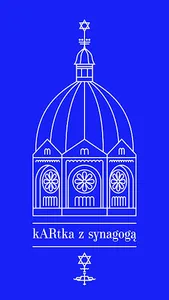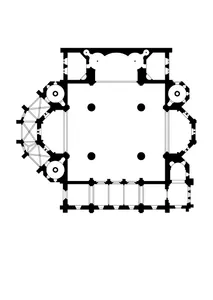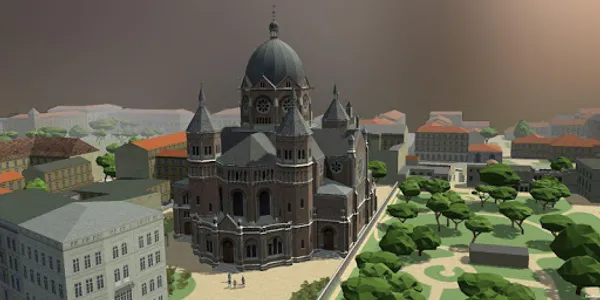kARtka z synagoga is a simple application that uses the possibilities of augmented reality (Augmented Reality, AR), which works in conjunction with a postcard (tracker).
On its internal side is the plan of the Synagogue on Wygon, the largest synagogue in Wrocław, destroyed in 1938. Each smartphone owner can view the 3D model of the synagogue using the application. Just follow the instructions displayed in the application and point the phone camera at the projection printed on the postcard (you can also download the postcard from the application's website and print it yourself: https://arvr.hs-mainz.de/img/pocztowka.pdf).
The application accompanies the project of digital reconstruction of the Synagogue on the Embankment, which will allow to restore this object to the virtual iconosphere of the city and deepen knowledge about it in the context of multicultural and multi-religious Wrocław in the 19th and 20th centuries. As part of this project, apart from the model itself, a website with an extensive database will be created, documenting the reconstruction process and sources used, as well as showing the broad socio-cultural context associated with the creation of the temple.
The synagogue on Wygon was located at present ul. Podwale 34. It was built in the years 1865-1872 for the reformed branch of the Jewish kehilla according to the design of Edwin Oppler (1831-1880). It was a modern and representative temple, unmistakable in the panorama of the city thanks to the characteristic dome surrounded by four towers. Edwin Oppler, an author of the project, was born in Silesia and was one of the first architects of Jewish origin who obtained architectural education at a university and specialized in the design of synagogues.
In 2018, the 80th anniversary of the destruction of the synagogue during the pogrom of Jews in Nazi Germany, called the "Crystal Night", took place on the night of November 9-10, 1938. At that time, the Synagoga on Wygon shared the fate of many temples and buildings that were destroyed in anti-Semitic act of terror and vandalism directed against the Jewish population.
The Polish-German project dedicated to the Wrocław synagogue is an important element of restoring the memory of this unique facility both on a local and global scale, using modern methods of digital reconstruction of the destroyed cultural heritage.
Information about the project:
http://architekturinstitut.hs-mainz.de/projekte/digitale-rekonstruktion-der-breslauer-synagoge/
The synagogue on the Outcome in the context of the three religious communities. Digital reconstruction and documentation of the Wrocław synagogue (German: Synagoge am Anger im Kontext, Dreier Glaubensgemeinschaften, Digitale Rekonstruktion und Dokumentation der Breslauer Synagoge)
Project implemented by the Institute of Architecture in Hochschule Mainz (as a link: http://architekturinstitut.hs-mainz.de/) in Mainz
Time of realization:
March 2018 - August 2019
partners:
Institute of Art History at the University of Wroclaw,
The Bente Kahan Foundation,
Museum of Architecture in Wroclaw,
The City Museum of Wroclaw
Financial assistance:
Federal Government Representative for Culture and Media, Berlin
Foundation for Polish-German Cooperation, Warsaw
On its internal side is the plan of the Synagogue on Wygon, the largest synagogue in Wrocław, destroyed in 1938. Each smartphone owner can view the 3D model of the synagogue using the application. Just follow the instructions displayed in the application and point the phone camera at the projection printed on the postcard (you can also download the postcard from the application's website and print it yourself: https://arvr.hs-mainz.de/img/pocztowka.pdf).
The application accompanies the project of digital reconstruction of the Synagogue on the Embankment, which will allow to restore this object to the virtual iconosphere of the city and deepen knowledge about it in the context of multicultural and multi-religious Wrocław in the 19th and 20th centuries. As part of this project, apart from the model itself, a website with an extensive database will be created, documenting the reconstruction process and sources used, as well as showing the broad socio-cultural context associated with the creation of the temple.
The synagogue on Wygon was located at present ul. Podwale 34. It was built in the years 1865-1872 for the reformed branch of the Jewish kehilla according to the design of Edwin Oppler (1831-1880). It was a modern and representative temple, unmistakable in the panorama of the city thanks to the characteristic dome surrounded by four towers. Edwin Oppler, an author of the project, was born in Silesia and was one of the first architects of Jewish origin who obtained architectural education at a university and specialized in the design of synagogues.
In 2018, the 80th anniversary of the destruction of the synagogue during the pogrom of Jews in Nazi Germany, called the "Crystal Night", took place on the night of November 9-10, 1938. At that time, the Synagoga on Wygon shared the fate of many temples and buildings that were destroyed in anti-Semitic act of terror and vandalism directed against the Jewish population.
The Polish-German project dedicated to the Wrocław synagogue is an important element of restoring the memory of this unique facility both on a local and global scale, using modern methods of digital reconstruction of the destroyed cultural heritage.
Information about the project:
http://architekturinstitut.hs-mainz.de/projekte/digitale-rekonstruktion-der-breslauer-synagoge/
The synagogue on the Outcome in the context of the three religious communities. Digital reconstruction and documentation of the Wrocław synagogue (German: Synagoge am Anger im Kontext, Dreier Glaubensgemeinschaften, Digitale Rekonstruktion und Dokumentation der Breslauer Synagoge)
Project implemented by the Institute of Architecture in Hochschule Mainz (as a link: http://architekturinstitut.hs-mainz.de/) in Mainz
Time of realization:
March 2018 - August 2019
partners:
Institute of Art History at the University of Wroclaw,
The Bente Kahan Foundation,
Museum of Architecture in Wroclaw,
The City Museum of Wroclaw
Financial assistance:
Federal Government Representative for Culture and Media, Berlin
Foundation for Polish-German Cooperation, Warsaw
Show More


